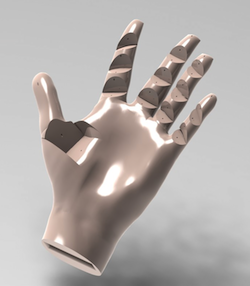Competitive prizes help move printable prosthetic hand closer to market
With an inexpensive, body-powered prosthetic that replicates an amputee’s lost hand, a University of Wisconsin–Madison mechanical engineering student earned second place in the undergraduate division of the 2012 National Collegiate Inventors Competition, held in Washington, D.C., in November.

Eric Ronning used an MRI of an amputee’s existing hand to create and print a lifelike prosthetic — right down to elegantly formed, fully hinged fingers.
Photo: Eric Ronning
Developed by junior Eric Ronning, the ReHand draws on the same shoulder harness that enables users of body-powered prosthetic hooks to grip and release objects. And, capitalizing on the precision of high-end 3-D printing technologies, Ronning uses an MRI of an amputee’s existing hand to create and print a lifelike prosthetic — right down to elegantly formed, fully hinged fingers. “It’s not just a better looking prosthetic,” he says. “It’s their hand that they lost. It’s a mirror image, so it’s a lot more personal.”
An alternative to both the hook and the more expensive, technically complex myoelectric prosthesis, the ReHand can attach to an existing body-powered prosthetic socket.
Ronning was the only single-person team among seven undergraduate finalist teams selected to participate in the competition, which is sponsored by the Abbott Fund, the nonprofit foundation of the global health care company Abbott; the Ewing Marion Kauffman Foundation; and the United States Patent and Trademark Office (USPTO).
For his second-place finish, Ronning received $12,000 — $2,000 of which will go to his advisor, T. Rockwell Mackie, a medical physicist, inventor, entrepreneur and current director of medical devices at the Morgridge Institute for Research at UW–Madison.
Judges for the final round of the competition include inductees to the National Inventors Hall of Fame, as well as other experts, who attend the finalists’ formal invention presentations and evaluate on their entries’ originality and inventiveness, level of development, potential impact or benefit to society, and level of student initiative. “Overwhelmingly, the advice they gave me was stick with it — and pursue other things aggressively, as well,” says Ronning.
The “Eureka!” moment for Ronning’s idea came when he was a freshman in a statics class studying how to use pulleys to differentiate a system. “I had just read an article about current prosthetics and how they needed development, especially on the body-powered versions,” he says. “It was swirling in my mind — and a whole bunch of ideas came together.”
“Just to see where the future could be … I feel like you could change the world with this idea. And that’s what keeps me going.”
Eric Ronning
Working at Sector67, a Madison-based inventor space founded by UW–Madison mechanical engineering alumnus Chris Meyer, Ronning developed the first version of his prosthetic hand — an inexpensive model designed for amputees in developing countries. He entered it in the 2012 UW–Madison Innovation Days competition, earning first prize and $10,000 in the Schoofs Prize for Creativity, and second place and $1,250 in the Tong Prototype Prize. “After I won, that was kind of an indicator that maybe I could continue doing this and make a product,” he says. “With the capital, I actually had the means of doing that.”
With feedback from competition judge Justin Beck, a UW–Madison electrical and computer engineering alum and co-founder and CEO of Madison gaming company PerBlue, Ronning began working on another iteration of his idea. This time, it was a higher-end hand designed for the U.S. market and a product whose revenue could support the “freemium” version for developing nations.
Sector 67’s Meyer introduced Ronning to Mackie. Ronning also entered and was a finalist in the UW–Madison Global Stewards Sustainability Prize and a runner-up in the group division of the 2012 UW–Madison G. Steven Burrill Business Plan Competition. “Understanding the market and the customer is key — and that’s something I learned from doing the Burrill,” he says.
Now, Ronning has his own product development and research company, a firm simply called Re. He’s hiring a design engineer with experience in aesthetics to help him perfect the ReHand’s materials and grip. He’s working with the UW–Madison Law and Entrepreneurship Clinic to patent his invention.
And, he’s looking forward to completing the ReHand and moving on to the other ideas swirling around in his head. Yet, given that in the United States, nearly 30 million people have experienced amputations or are at risk for one, he acknowledges the device may never be fully finished. “I feel there’s this huge need for this,” he says. “So, just to see where the future could be — with 3-D printing and scanning — I feel like you could change the world with this idea. And that’s what keeps me going.”



